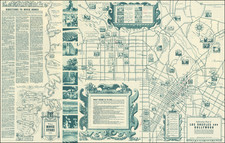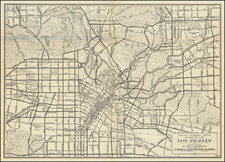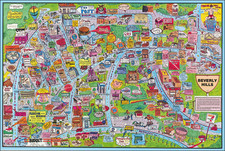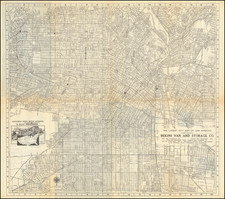The Earliest Map of Los Angeles & Santa Barbara Region
This 1825 map by Philippe Marie Vandermaelen offers a detailed depiction of the regions surrounding Los Angeles, Santa Barbara, the Channel Islands, and Central Coast. It is recognized for being the first comprehensive cartographic representation of these areas, stretching from Catalina Island and San Pedro Bay to just north of Morro Bay.
This map hails from a transformative era in cartographic history when the world was being mapped on a uniform scale for the first time. Vandermaelen, a Brussels-based cartographer, was at the forefront of this evolution. His grand project, a six-volume atlas designed to form an immense globe when assembled as globe gores, represents a significant milestone in the field of cartography.
The map provides invaluable insight into the early development of California's central and southern coast, particularly the establishment of the mission system. It names several missions from San Gabriel in the south to Santa Barbara, San Luis Obispo, and Mission San Antonio. Prominent geographical features like Mission San Fernando, Pt. Dume, and Pt. Fermin are also marked.
Vandermaelen's detailed mapping of this region is particularly notable given the time it was created. During the early 19th century, American publishers were largely neglecting the Western United States. By contrast, Vandermaelen undertook the challenge of charting this territory across 20 sheets, providing an unprecedented view of the area. This map serves as a testament to Vandermaelen's visionary approach to cartography, as well as a valuable record of the early development of Southern and Central California.
Philippe Marie Vandermaelen (1795-1869) was a Belgian cartographer and geographer known for his pioneering use of technology and his leadership in establishing the important Establissement geographique de Bruxelles. Born in Brussels, Philippe was obsessed with maps from a young age. He taught himself mathematics, astronomy, and mapmaking and plotted the battles of the Napoleonic wars avidly. He took over his father’s soapmaking business briefly in 1816, but then turned it over to his brother in favor of cartography.
From 1825 to 1827, he released his first atlas, the Atlas universal, which was well received. It was sold in forty installments of ten maps each, with 810 subscribers listed. The atlas contained 387 maps in six volumes at a uniform scale of 1:1.6 million. The maps were intended to be joined and together would create a globe 7.755 meters wide. It was the first atlas to show the entire world on a large uniform scale and was the first atlas produced using lithography. This project served as Vandermaelen’s gateway into intellectual life, gaining him membership in the Royal Academy of Sciences and Belles-Lettres of Brussels (1829).
In 1830, Vandermaelen inherited a laundry from his parents which he converted into the Establissement geographique de Bruxelles, or the Brussels Geographical Establishment. His brother, Jean-Francois, also established a botanical garden on the site. The Establishment had its own lithographic press, one of the first to use the technology for cartography and the first in Belgium. They produced textbooks, surveys, and especially maps of Brussels to be used for urban planning. The complex also housed schools, an ethnographic museum, and a library open to the public. Vandermaelen was passionate about geographic education and saw the Establishment as an open place where people could learn about the world.
In 1836, he was knighted for his services to geography and the intellectual community of Belgium. He died at age 73 in Molenbeek-Saint-Jean, near the Geographical Establishment that he founded. After Vandermaelen’s death, the Geographical Establishment declined, closing its doors in 1880. The extraordinary collection they had amassed passed to several institutions, most importantly the Royal Library of Belgium.









![[ NAACP Banquet - Los Angeles ] National Association for the Advancement of Colored People Human Rights Banquet Honoring Philip Murray -- Alexandria Hotel, Los Angeles, Calif - Jan 16, 1953](https://storage.googleapis.com/raremaps/img/small/99632.jpg)
![(Los Angeles Architecture) [Photograph of a 1920s Spanish Colonial Revival home, likely in the Hollywood Hills area; with glass plate negative]](https://storage.googleapis.com/raremaps/img/small/96755.jpg)



